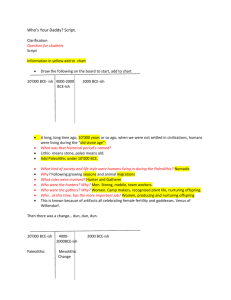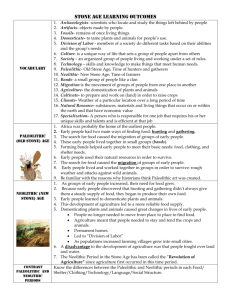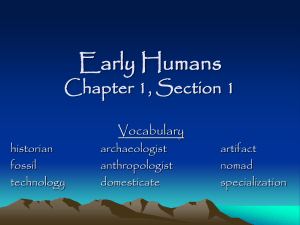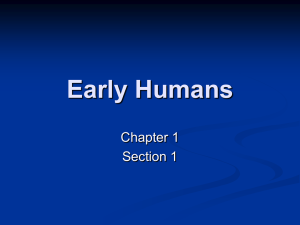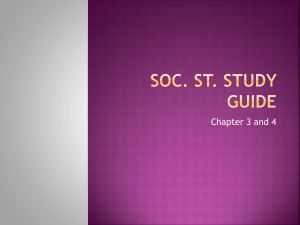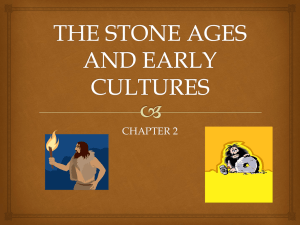Early Humans Vocabulary List I
advertisement
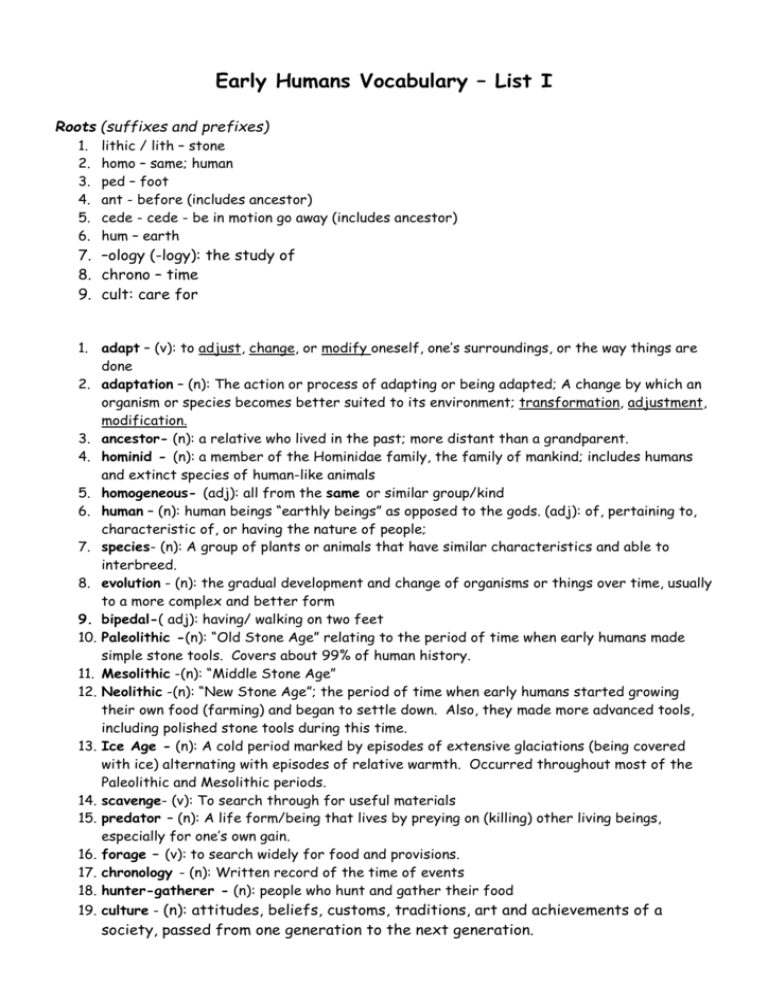
Early Humans Vocabulary – List I Roots (suffixes and prefixes) 1. 2. 3. 4. 5. 6. lithic / lith – stone homo – same; human ped – foot ant - before (includes ancestor) cede - cede - be in motion go away (includes ancestor) hum – earth 7. –ology (-logy): the study of 8. chrono – time 9. cult: care for 1. adapt – (v): to adjust, change, or modify oneself, one’s surroundings, or the way things are done 2. adaptation – (n): The action or process of adapting or being adapted; A change by which an organism or species becomes better suited to its environment; transformation, adjustment, modification. 3. ancestor- (n): a relative who lived in the past; more distant than a grandparent. 4. hominid - (n): a member of the Hominidae family, the family of mankind; includes humans and extinct species of human-like animals 5. homogeneous- (adj): all from the same or similar group/kind 6. human – (n): human beings “earthly beings” as opposed to the gods. (adj): of, pertaining to, characteristic of, or having the nature of people; 7. species- (n): A group of plants or animals that have similar characteristics and able to interbreed. 8. evolution - (n): the gradual development and change of organisms or things over time, usually to a more complex and better form 9. bipedal-( adj): having/ walking on two feet 10. Paleolithic -(n): “Old Stone Age” relating to the period of time when early humans made simple stone tools. Covers about 99% of human history. 11. Mesolithic -(n): “Middle Stone Age” 12. Neolithic -(n): “New Stone Age”; the period of time when early humans started growing their own food (farming) and began to settle down. Also, they made more advanced tools, including polished stone tools during this time. 13. Ice Age - (n): A cold period marked by episodes of extensive glaciations (being covered with ice) alternating with episodes of relative warmth. Occurred throughout most of the Paleolithic and Mesolithic periods. 14. scavenge- (v): To search through for useful materials 15. predator – (n): A life form/being that lives by preying on (killing) other living beings, especially for one’s own gain. 16. forage – (v): to search widely for food and provisions. 17. chronology - (n): Written record of the time of events 18. hunter-gatherer - (n): people who hunt and gather their food 19. culture - (n): attitudes, beliefs, customs, traditions, art and achievements of a society, passed from one generation to the next generation. Vocabulary, Vocabulary, Vocabulary, Vocabulary Questions & Your Answers!! Answer the question using the vocabulary word in your answer. Your answer has to be in a complete sentence that can stand-alone and must show that you understand the word. You must completely answer the question! Example: Pretend the vocabulary word is ‘dangerous’. Dangerous – (adj): able or likely to cause physical injury; perilous, risky, threatening. Question: Do you know if that dog is dangerous? Good answer: Yes, that furry dog looks cute but it is aggressive and bites people; therefore, it is very dangerous. (Unlike Ms. Sanders’ dog Bandi who is just cute and adorable!) Bad answer: Yes, that dog is dangerous. This is a bad answer because it does not show you understand the word. Early Humans Vocabulary I: 1. What is one way you have adapted to middle school? 2. Where did your ancestors come from? 3. Where do archaeologists think that first hominids emerged? 4. Do you think the students at ISB are a homogeneous group? Why or why not? 5. What is one typical human characteristic? 6. To what species do modern humans belong? 7. How did tools evolve over time? 8. What are the advantages of bipedal humans? 9. For what reason is the Paleolithic period associated with stone? 10. How did Mesolithic period tools differ from Paleolithic tools? (just think about it!) 11. What is one remarkable thing that happens during the Neolithic period? 12. What made living during the Ice Age difficult? 13. What kinds of things did early man scavenge for? 14. When did early man become a predator? 15. When you are hungry at ISB, where do you forage for food? 16. Which is the correct chronology: (A) control of fire, walking up right, farming; or (B) walking up right, control of fire, farming. Explain your answer. 17. What were the usual gender roles in most hunter-gatherer societies? 18. What is one characteristic of your Culture?



